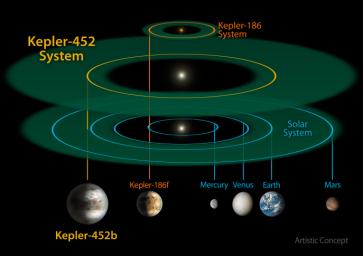Planetary System Comparisons
Caption:
This size and scale of the Kepler-452 system compared alongside the Kepler-186 system and the solar system. Kepler-186 is a miniature solar system that would fit entirely inside the orbit of Mercury. The habitable zone of Kepler-186 is very small compared to that of Kepler-452 or the sun because it is a much smaller, cooler star. The size and extent of the habitable zone of Kepler-452 is nearly the same as that of the sun, but is slightly bigger because Kepler-452 is somewhat older, bigger and brighter. The size of the orbit of Kepler-452b is nearly the same as that of Earth at 1.05 astronomical units (an astronomical unit is the distance between Earth and the sun). Kepler-452b orbits its star once every 385 days.
Background Info:
NASA Ames manages Kepler's ground system development, mission operations and science data analysis. NASA's Jet Propulsion Laboratory in Pasadena, Calif., managed Kepler mission development. Ball Aerospace & Technologies Corp. in Boulder, Colo., developed the Kepler flight system and supports mission operations with JPL at the Laboratory for Atmospheric and Space Physics at the University of Colorado in Boulder. The Space Telescope Science Institute in Baltimore archives, hosts and distributes the Kepler science data. Kepler is NASA's 10th Discovery Mission and is funded by NASA's Science Mission Directorate at the agency's headquarters in Washington.
More information about the Kepler mission is at
http://www.nasa.gov/kepler
.
More information about exoplanets and NASA's planet-finding program is at
http://planetquest.jpl.nasa.gov
.
Cataloging Keywords:
| Name |
Value |
Additional Values |
| Target |
Kepler-452 |
|
| System |
Kepler-452 |
|
| Target Type |
Exoplanet |
|
| Mission |
Kepler |
|
| Instrument Host |
Kepler |
|
| Host Type |
Space Telescope |
|
| Instrument |
|
|
| Detector |
|
|
| Extra Keywords |
Atmosphere, Color, Infrared, Orbit |
| Acquisition Date |
|
| Release Date |
2015-07-23 |
| Date in Caption |
|
|
| Image Credit |
NASA/Ames/JPL-Caltech |
| Source |
photojournal.jpl.nasa.gov/catalog/PIA19826 |
| Identifier |
PIA19826 |

 Planetary Data System
Planetary Data System
